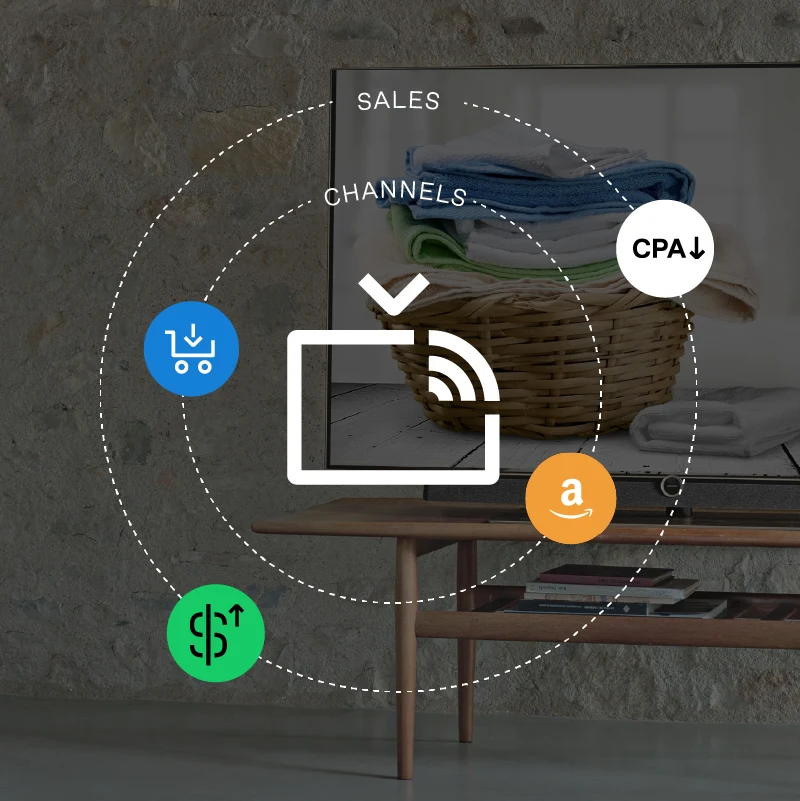
How A Leading CPG Brand Used TV to Drive Sales on Amazon and in Stores
Today, most products can be bought almost anywhere - in stores, online, through apps, or even mail order (my grandmother says that’s still a thing). While this makes buying incredibly easy for the consumer, it makes understanding the full impact of a brand's sales and marketing tactics awfully difficult. And with many products also being sold through third-party e-commerce sites like Amazon, getting a clear picture of a brand’s advertising’s impact on both retail and online sales is like trying to assemble a piece of furniture in the dark - without any instructions.
One of our clients, a rapidly growing packaged snack brand, faced a similar challenge. While they recognized TV was a promising way to promote their signature snacks and drive upper funnel metrics like brand awareness, they craved a more comprehensive approach to understand the far-reaching impact of their TV advertising campaigns.
TV has universally been lauded by the brand’s marketing team for its efficient CPMs compared to other awareness-building tactics. By layering in brand lift studies and evaluating search volumes, the team has continually been able to fine-tune TV as a brand channel. But they wondered if it could offer even more? While Tatari has been good at tracking website visits and conversions from TV ads, capturing the direct results those same ads have on sales in physical stores or on third-party platforms like Amazon has been a bit more challenging. But we were confident we could help them shine a light on their omnichannel sales performance.
A Smorgasbord of Sales Channels
The diversity of the brand’s sales channels, including their own website, shelf-space in nationally located brick-and-mortar stores, and third-party e-commerce sites, presented a significant attribution challenge. Each channel operated with its own unique dynamics and data accessibility issues, further complicating the process of measuring TV’s influence on sales. For example, while traffic on their website might see a spike immediately after one of their TV spots airs, retail purchases could be delayed until a customer's next grocery trip, potentially days or even weeks later. This disparity in response times and data granularity made it difficult to establish direct correlations between the time a TV ad ran and when a sale took place. When it comes to food, there’s typically less urgency between when a viewer sees an ad and the time of a purchase; unless you’re pretty ravenous at the time it’s shown. Guilty.
Further compounding the measurement challenge was the inconsistency in data formats and reporting schedules across various sales channels. Website data was available in real-time while retail sales data might be reported a week or month out. Meanwhile, third-party e-commerce platforms had their own reporting timelines and formats. This lack of uniformity made it difficult to align and analyze data from all channels simultaneously.
To address these measurement challenges, Tatari devised a pilot plan consisting of two key components: geo-testing and an Amazon sales analysis.
Geo-Testing: Measuring TV’s Impact Across Markets
A geo-based test involves running media campaigns in selected markets while excluding others, creating a treatment group to compare against a control group. This approach is particularly effective for brick-and-mortar retail stores due to the weekly granularity of available data. By comparing sales performance in test markets versus control markets, the brand could isolate the impact of TV advertising on retail sales, as represented by the chart below:
The same analysis could also be applied simultaneously to Amazon and DTC website conversions, providing a comprehensive assessment of TV's incremental impact across all channels.
Tatari partnered with brand on a six-week pilot program incorporating both linear and streaming TV advertising. The campaign targeted 18 million impressions across Minnesota, Kansas City, and Louisville, locations chosen based on historical data analysis and optimized for generating adequate lift. This analysis involved looking at thousands of possible DMA combinations and evaluating the historical predictive accuracy of a synthetic control group. Given that this was their first foray into TV advertising, assumptions about consumer response rates were based on industry averages and product price points.
The campaign data, collected weekly at the DMA level, was provided by brick-and-mortar retailers and aggregated from Amazon and the DTC website. This data allowed Tatari to analyze the impact on retail sales in test markets compared to control markets, as well as to observe trends in Amazon sales that correlated with their TV campaigns. The holistic approach aimed to reveal overall performance insights that single-channel analysis could not provide.
Unlocking Amazon Sales Data
In addition to the geo-testing which helped the brand start to get a clearer picture of their TV efforts, Tatari provided them with an Amazon Sales report that shed light on the weekly combined TV cost per acquisition (CPA), factoring in both Amazon and website purchases. Because Amazon is a walled garden ecosystem, Tatari does not receive any filterable information (IP-level or pixel data). Due to the significant noise in the data, it is difficult to find a clean TV signal when relying on the traditional baseline-lift methodology. Instead, Tatari utilized a top-down regression analysis to estimate an Amazon TV CPA. This approach provided the brand with a holistic view of their Amazon TV CPA across the entire campaign period, including weeks when media performance may not have been fully optimized due to the controlled environment of the geo-test.
Based on this analysis, TV was estimated to have driven 8.26% of the brand’s Amazon purchases, aligning with TV’s allocation of approximately 8-12% of their total marketing budget. When focusing solely on website orders, the TV CPA stood at $212.20. However, Amazon, contributed over 87% of the total purchase share, and had a CPA of $15.63. When combined, the overall TV CPA dropped to $14.56. This analysis gave our client a valuable benchmark to measure the true cost efficiency of their Amazon-focused media, enabling them to make data-driven decisions and optimize their advertising strategy.
By combining geo-testing with a detailed analysis of Amazon sales, the brand gained a deeper understanding of how TV advertising influenced their other sales channels. Today, they view TV as a full-funnel marketing channel to help lift awareness and drive offline sales.

Sabrina An
I am a Data Scientist at Tatari. I crunch numbers by day and creep myself out with scary stories at night.
Related
How a DTC Brand Used Tatari's TV Advertising to Drive Revenue and Business Outcomes on Amazon
An eco-friendly cleaning product company found that TV advertising boosts Amazon sales, as confirmed by Tatari's analysis. This approach revealed that TV not only drives direct sales but also enhances customer acquisition across channels, underscoring its importance for DTC brands.
Read more
Watch: How Tecovas Turned TV Into a Growth Engine
Watch our GROW LA session with Tecovas to hear how they made TV a cornerstone of their marketing strategy.
Read more
Marketing Minds: Gusto’s David De Rosa Breaks Down Why TV is a Growth Channel
Tatari dives into the mind of Gusto’s Head of Paid Acquisition to talk everything from TV creative to TV measurement.
Read more


